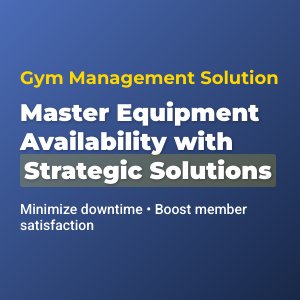Abstract: .
**Summary:**
This article focuses on the challenges faced by gym managers regarding equipment gaps and offers a strategic solution: strategic warehousing. It highlights the costs associated with equipment gaps, including lost revenue, member dissatisfaction, and increased repair costs. The article then introduces strategic warehousing as a proactive system that involves needs assessment, tiered inventory management, strategic location of warehouse, and the integration of technology. Benefits of strategic warehousing include reduced downtime, cost savings, and improved member retention. The piece emphasizes the importance of planning and investment in strategic warehousing to minimize disruptions and ensure the availability of equipment when needed, ultimately enhancing the member experience.

Gym Managers: Master Equipment Availability with Strategic Fitness Equipment Solutions
Running a successful gym involves a delicate balance of member satisfaction, staff management, and maintaining a top-tier fitness environment. One of the most challenging aspects for gym managers is addressing equipment gaps—those frustrating moments when essential fitness equipment is unavailable, broken, or missing. These gaps can lead to lost revenue, member dissatisfaction, and a tarnished gym reputation. But what if there was a way to minimize these gaps and ensure your gym is always equipped with the right fitness tools?
The solution lies in adopting a strategic approach to fitness equipment management. This isn't just about storing extra equipment; it's about building a proactive system that anticipates needs, reduces downtime, and enhances the member experience. Let's explore how strategic fitness equipment solutions can transform your gym's operations.
The Problem: The Hidden Costs of Equipment Gaps
Equipment gaps are more than just an inconvenience—they can be a significant drain on your gym's resources and reputation. Here’s a breakdown of the impacts:
- Lost Revenue: When key equipment is unavailable, members may skip workouts or even consider canceling their memberships.
- Member Dissatisfaction: Inconvenience and broken equipment lead to frustration, which can spread quickly and harm your gym's reputation.
- Increased Repair Costs: Reactive repairs are often more expensive than preventative maintenance or proactive replacement.
- Delayed Upgrades: Without a strategic plan, upgrading to newer equipment can be a logistical nightmare, causing downtime and disruption.
- Supply Chain Challenges: Relying solely on ordering equipment when needed leaves you vulnerable to delays and price fluctuations.
The Solution: Strategic Fitness Equipment Management
Strategic fitness equipment management is a proactive inventory strategy designed to minimize equipment gaps. It involves:
- Needs Assessment & Forecasting: Understand your gym's specific needs by analyzing equipment usage, maintenance records, member feedback, and industry trends.
-
Tiered Inventory System: Implement a three-tier system:
- Tier 1: Essential replacement parts for frequently used equipment.
- Tier 2: Complete replacement units for critical machines.
- Tier 3: Future-proofing stock with newer models aligned with emerging fitness trends.
- Optimal Storage Solutions: Choose between on-site storage, off-site warehouses, or partner warehousing based on your gym's needs.
- Technology Integration: Use inventory management software, QR codes, and mobile apps to streamline tracking and maintenance.
- Regular Audits & Maintenance: Keep your inventory accurate and equipment in good condition.
Benefits Beyond Replacements
While reducing equipment gaps is the primary advantage, strategic fitness equipment management offers additional benefits:
- Reduced Downtime: Faster replacements mean less disruption to member workouts.
- Cost Savings: Proactive management often reduces repair costs and allows for bulk purchasing discounts.
- Improved Retention: A well-maintained gym fosters member loyalty.
- Operational Efficiency: Streamlined processes free up staff for other critical tasks.
- Flexibility for Growth: Having reserve equipment makes it easier to expand or introduce new programs.
Choosing the Right Strategy
The best approach depends on your gym's size, budget, and operational needs. Consider factors like space availability, supplier relationships, and staffing when selecting a storage solution.
Real-World Examples
- Large Franchise Gyms: Use regional warehouses and data analytics for efficient inventory management.
- Boutique Studios: Maintain essential parts on-site for high-intensity equipment.
- University Recreation Centers: Partner with local suppliers for maintenance and replacement services.
Conclusion: Invest in a Proactive Approach
In the competitive fitness industry, providing a seamless member experience is crucial. Strategic fitness equipment management is a powerful tool for achieving this. By proactively managing your inventory, you can minimize equipment gaps, reduce downtime, and enhance member satisfaction. Don't wait until the next equipment failure disrupts your operations—invest in a strategic plan today.
Ready to elevate your gym's equipment management? Contact us for a free consultation and discover how we can help you implement a customized fitness equipment solution.














